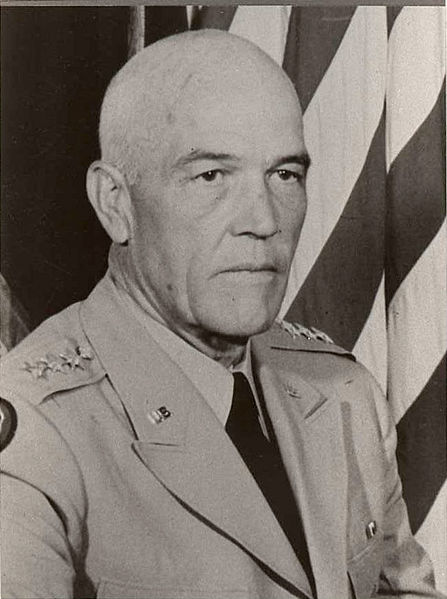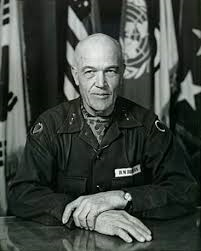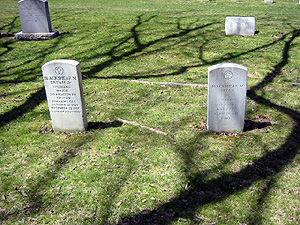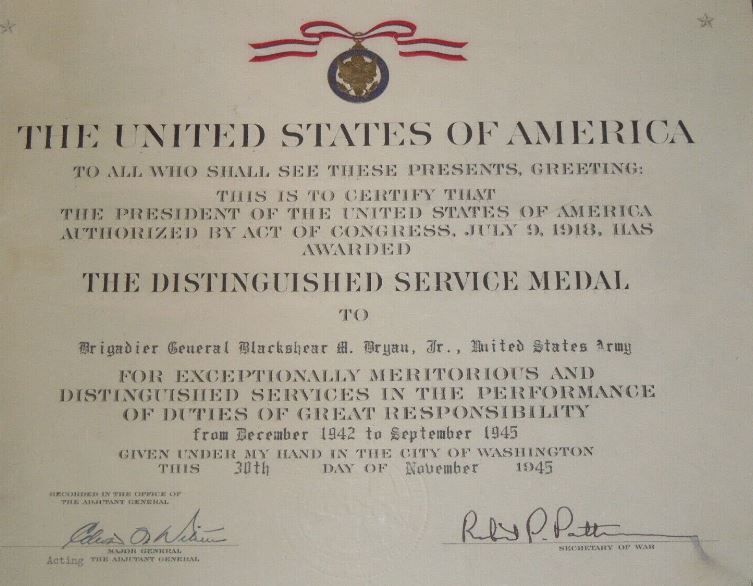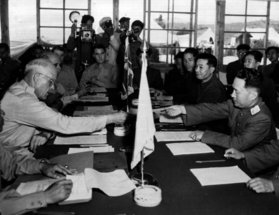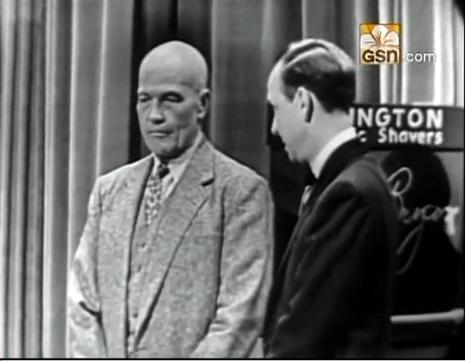Blackshear Morrison Bryan was born in Alexandria, Louisiana on 8 February 1900. In 1918, he was attending Virginia Military Institute when he received an appointment to the U.S. Military Academy. Because of World War I, two classes were graduated from the academy in 1922. Bryan was with the portion of the Class of 1923 that graduated in three years, after an accelerated course of studies. Bryan received a commission as a Second Lieutenant of Artillery.
After graduation from the Academy, Bryan attended Artillery Officer Training at Fort Sill, Oklahoma. He returned to West Point to serve as an assistant Army football coach during the 1925 and 1926 seasons. Bryan was also an instructor there in 1928-1929, and again in 1933-1934. He was promoted to First Lieutenant in 1927 and to Captain in 1935. In 1940, he was promoted to Major and graduated from the Army War College before it was closed for the duration of World War II. At that time, the college was located at Washington Barracks (now Fort Lesley J. McNair) in Washington, DC.
At the outbreak of World War II, Bryan was Chief of the Policy Section for the War Department General Staff in Washington, DC, where he was promoted to Lieutenant Colonel. In 1942, he was promoted to Colonel and assigned as Chief of the Aliens Division for the Provost Marshal General's Office. Bryan was promoted to Brigadier General and, in a 1943 reorganization of the Provost Marshal General's Office, he headed the Prisoner of War Division with charge over Japanese internment and prisoner of war camps throughout the United States. In July 1945, Bryan became Provost Marshal General and transitioned an agency whose lifespan rarely extended beyond the end of combat hostilities, into a post-war organization with charge over Army military investigations, the military police and the Army's military police school.
In 1948, Bryan transferred to the Panama Canal Zone, serving as Chief of Staff under General Matthew Ridgway who headed a newly established unified multi-service command structure, the Caribbean Command, replacing the Army's World War II Caribbean Defense Command.
In March 1951, Bryan was part of the first rotation of combat commanders since the start of the Korean War, taking charge of the 24th Infantry Division, a first combat command that he took on with Ridgway's full faith, despite not having any combat experience.
After a year in Korea, Bryan served as Deputy Chief of Staff for the Far East Command in Tokyo before taking command of the XVI Corps in Japan. He then took a leading role on the Military Armistice Commission of the United Nations which concluded hostilities in Korea in 1953 and directed the repatriation of prisoners of war. After promotion to lieutenant general and a short stint as commanding general of I Corps in Korea, he was appointed the 43rd Superintendent of the United States Military Academy at West Point, where he served from 1954 to 1956.
When he became Superintendent of the Academy in 1954, Lieutenant General Bryan became the highest ranking superintendent in the history of the Academy. Robert Ten Broeck Stevens, Secretary of the Army, had discussed the West Point superintendency with President Dwight D. Eisenhower at a White House meeting on 10 February 1954. and had written the President about the appointment on 17 February 1954. Having considered the qualities that President Eisenhower had defined as necessary for the position, Secretary Stevens had called Bryan "a logical and wise choice." Upholding his choice of a lieutenant general to hold the position, Stevens wrote to Eisenhower "This should not be a bar to the appointment of so highly qualified an officer for such a vitally important post. It can but enhance the prestige of the Academy."
On 19 February 1954, President Eisenhower sent this memorandum to Secretary Stevens about the appointment:
"Thank you very much for your memorandum giving me the reasons for the selection of Bryan at West Point. Of course, I agree--so long as you have carefully considered the possible effect of detailing a three-star general to that post.
Incidentally, the next time that you are in my office please remember to outline for me the considerations that govern the assignment of three and four-star generals. The reason for asking is that it is my understanding that these particular grades were automatically given to people occupying specific positions. All of them, I believe, are temporary and I know that when first authorized the theory was grade for position. This must not be completely true because you have not requested me, as President, to designate the West Point, permanently, as one of these posts."
Eisenhower later made the designation and the Superintendent position at West Point now calls for a lieutenant general.
Lieutenant General Bryan appeared as a guest on the 30 March 1955 episode of the television show, ‘What's My Line.' The general's ‘line' was that he was Superintendent of the U.S. Military Academy at West Point, which was celebrating its 153rd anniversary.
After leaving the Academy in July 1956, Lieutenant General Bryan became Commander-in-Chief, U.S. Army Pacific in Hawaii. In July 1957, Bryan assumed his final military assignment as Commanding General of the First United States Army at Fort Jay, Governors Island, in New York City. After 37 years of active duty, Bryan entered the retired list 29 February 1960.
During his military career, Bryan received the following medals and awards:
Distinguished Service Medal (Army)
Order of the British Empire
Air Medal (In Korea)
After his retirement in 1960, Bryan served as the first president of the Nassau Community College in Long Island, New York, until 1965.
Two of Bryan's sons, Blackshear M. "Morrie" Bryan, Jr., and James Edward "Jamie" Bryan, also served in the U.S. Army. Morrie was born at West Point in 1929 during his father's tenure as assistant football coach. He graduated from the U.S. Military Academy with the class of 1954 and accepted a commission as a Second Lieutenant in the U. S. Air Force. He transferred to the U.S. Army in 1963. Morrie served in Vietnam and was cited twice for heroism during his tour. During a training mission on 22 September 1967, as he was completing his tour in Vietnam, Major Morrie Bryan was killed in the crash of his U-21A aircraft as he attempted to avoid trespassers on the runway.
Jamie Bryan graduated from the U.S. Military Academy with the class of 1965 and was commissioned as a Second Lieutenant in the Infantry. He served two tours in Vietnam, in 1967 and 1969. He was wounded during both tours and was twice awarded the Purple Heart Medal and the Silver Star Medal for gallantry. Like his brother Morrie, Major Jamie Bryan also died in the crash of a military aircraft. At 23:48 hours on 14 September 1977, Jamie was coordinating his unit's operations from aboard an Air Force Boeing EC-135K command and control aircraft that had just taken off from Kirtland Air Force Base, near Albuquerque, NM. Shortly after takeoff, the aircraft banked right and crashed into a mountain peak in the Manzano Mountain range, killing all 20 military crew members aboard. (Investigators said that fatigue may have played a part in the accident.)
Lieutenant General Blackshear Morrison Bryan died 2 March 1977, in a Silver Spring, MD nursing home after a long illness. He was buried next to his son, Morrie, at the U.S. Military Academy Post Cemetery at West Point. On 22 September 1977, exactly ten years after Morrie's death in Vietnam, and just over six months after the death of his father, Jamie was buried next to his brother and father. This was a family that truly embodied the ideals of "Duty, Honor, Country."
LTG Blackshear M. Bryan has Honoree Record 3265 at MilitaryHallofHonor.com.
Bio compiled by Charles A. Lewis.
Blackshear Morrison Bryan was born in Alexandria, Louisiana on 8 February 1900. In 1918, he was attending Virginia Military Institute when he received an appointment to the U.S. Military Academy. Because of World War I, two classes were graduated from the academy in 1922. Bryan was with the portion of the Class of 1923 that graduated in three years, after an accelerated course of studies. Bryan received a commission as a Second Lieutenant of Artillery.
After graduation from the Academy, Bryan attended Artillery Officer Training at Fort Sill, Oklahoma. He returned to West Point to serve as an assistant Army football coach during the 1925 and 1926 seasons. Bryan was also an instructor there in 1928-1929, and again in 1933-1934. He was promoted to First Lieutenant in 1927 and to Captain in 1935. In 1940, he was promoted to Major and graduated from the Army War College before it was closed for the duration of World War II. At that time, the college was located at Washington Barracks (now Fort Lesley J. McNair) in Washington, DC.
At the outbreak of World War II, Bryan was Chief of the Policy Section for the War Department General Staff in Washington, DC, where he was promoted to Lieutenant Colonel. In 1942, he was promoted to Colonel and assigned as Chief of the Aliens Division for the Provost Marshal General's Office. Bryan was promoted to Brigadier General and, in a 1943 reorganization of the Provost Marshal General's Office, he headed the Prisoner of War Division with charge over Japanese internment and prisoner of war camps throughout the United States. In July 1945, Bryan became Provost Marshal General and transitioned an agency whose lifespan rarely extended beyond the end of combat hostilities, into a post-war organization with charge over Army military investigations, the military police and the Army's military police school.
In 1948, Bryan transferred to the Panama Canal Zone, serving as Chief of Staff under General Matthew Ridgway who headed a newly established unified multi-service command structure, the Caribbean Command, replacing the Army's World War II Caribbean Defense Command.
In March 1951, Bryan was part of the first rotation of combat commanders since the start of the Korean War, taking charge of the 24th Infantry Division, a first combat command that he took on with Ridgway's full faith, despite not having any combat experience.
After a year in Korea, Bryan served as Deputy Chief of Staff for the Far East Command in Tokyo before taking command of the XVI Corps in Japan. He then took a leading role on the Military Armistice Commission of the United Nations which concluded hostilities in Korea in 1953 and directed the repatriation of prisoners of war. After promotion to lieutenant general and a short stint as commanding general of I Corps in Korea, he was appointed the 43rd Superintendent of the United States Military Academy at West Point, where he served from 1954 to 1956.
When he became Superintendent of the Academy in 1954, Lieutenant General Bryan became the highest ranking superintendent in the history of the Academy. Robert Ten Broeck Stevens, Secretary of the Army, had discussed the West Point superintendency with President Dwight D. Eisenhower at a White House meeting on 10 February 1954. and had written the President about the appointment on 17 February 1954. Having considered the qualities that President Eisenhower had defined as necessary for the position, Secretary Stevens had called Bryan "a logical and wise choice." Upholding his choice of a lieutenant general to hold the position, Stevens wrote to Eisenhower "This should not be a bar to the appointment of so highly qualified an officer for such a vitally important post. It can but enhance the prestige of the Academy."
On 19 February 1954, President Eisenhower sent this memorandum to Secretary Stevens about the appointment:
"Thank you very much for your memorandum giving me the reasons for the selection of Bryan at West Point. Of course, I agree--so long as you have carefully considered the possible effect of detailing a three-star general to that post.
Incidentally, the next time that you are in my office please remember to outline for me the considerations that govern the assignment of three and four-star generals. The reason for asking is that it is my understanding that these particular grades were automatically given to people occupying specific positions. All of them, I believe, are temporary and I know that when first authorized the theory was grade for position. This must not be completely true because you have not requested me, as President, to designate the West Point, permanently, as one of these posts."
Eisenhower later made the designation and the Superintendent position at West Point now calls for a lieutenant general.
Lieutenant General Bryan appeared as a guest on the 30 March 1955 episode of the television show, ‘What's My Line.' The general's ‘line' was that he was Superintendent of the U.S. Military Academy at West Point, which was celebrating its 153rd anniversary.
After leaving the Academy in July 1956, Lieutenant General Bryan became Commander-in-Chief, U.S. Army Pacific in Hawaii. In July 1957, Bryan assumed his final military assignment as Commanding General of the First United States Army at Fort Jay, Governors Island, in New York City. After 37 years of active duty, Bryan entered the retired list 29 February 1960.
During his military career, Bryan received the following medals and awards:
Distinguished Service Medal (Army)
Order of the British Empire
Air Medal (In Korea)
After his retirement in 1960, Bryan served as the first president of the Nassau Community College in Long Island, New York, until 1965.
Two of Bryan's sons, Blackshear M. "Morrie" Bryan, Jr., and James Edward "Jamie" Bryan, also served in the U.S. Army. Morrie was born at West Point in 1929 during his father's tenure as assistant football coach. He graduated from the U.S. Military Academy with the class of 1954 and accepted a commission as a Second Lieutenant in the U. S. Air Force. He transferred to the U.S. Army in 1963. Morrie served in Vietnam and was cited twice for heroism during his tour. During a training mission on 22 September 1967, as he was completing his tour in Vietnam, Major Morrie Bryan was killed in the crash of his U-21A aircraft as he attempted to avoid trespassers on the runway.
Jamie Bryan graduated from the U.S. Military Academy with the class of 1965 and was commissioned as a Second Lieutenant in the Infantry. He served two tours in Vietnam, in 1967 and 1969. He was wounded during both tours and was twice awarded the Purple Heart Medal and the Silver Star Medal for gallantry. Like his brother Morrie, Major Jamie Bryan also died in the crash of a military aircraft. At 23:48 hours on 14 September 1977, Jamie was coordinating his unit's operations from aboard an Air Force Boeing EC-135K command and control aircraft that had just taken off from Kirtland Air Force Base, near Albuquerque, NM. Shortly after takeoff, the aircraft banked right and crashed into a mountain peak in the Manzano Mountain range, killing all 20 military crew members aboard. (Investigators said that fatigue may have played a part in the accident.)
Lieutenant General Blackshear Morrison Bryan died 2 March 1977, in a Silver Spring, MD nursing home after a long illness. He was buried next to his son, Morrie, at the U.S. Military Academy Post Cemetery at West Point. On 22 September 1977, exactly ten years after Morrie's death in Vietnam, and just over six months after the death of his father, Jamie was buried next to his brother and father. This was a family that truly embodied the ideals of "Duty, Honor, Country."
LTG Blackshear M. Bryan has Honoree Record 3265 at MilitaryHallofHonor.com.
Bio compiled by Charles A. Lewis.







